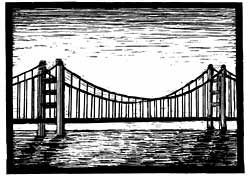Bench to Bedside: Building bridges
The field of academic technology transfer—the process of transferring scientific findings from university research to the commercial sector for the public's benefit—was born with the enactment of the 1980 Patent and Trademark Law Amendments Act. Before the adoption of what is commonly known as the "Bayh-Dole Act" (named for its cosponsors, U.S. Senators Birch Bayh and Robert Dole), universities could not hold title to inventions their employees had developed with federal dollars. Instead, the federal government owned such patents and granted only nonexclusive licenses to anyone who wanted to develop and manufacture products resulting from the inventions— everything from medical devices to biotechnology products, computer software to research tools.
Thus there was little economic incentive for companies to invest in commercializing such inventions, since they were also available to competitors. This was a particular problem for the biomedical industry, where the development of new products involves the lengthy and expensive Food and Drug Administration approval process. So it's not surprising that as of 1980, fewer than 5% of the 28,000 governmentowned patents were licensed to industry.
 Illustration by Suzanne DeJohn Technology transfer, therefore, is a bridge between academia and industry. Such collaboration is steadily expanding. |
Innovations: The passage of the Bayh-Dole Act reflected a growing understanding of how much the public would benefit from a policy that facilitated collaboration among government, universities, and private industry to bring inventions to market. Indeed, the new federal policy stimulated the economy as well as the development of academic inventions. Since the passage of the act, the number of patents issued to U.S. universities has grown from 250 to more than 1,500 a year. And according to a survey conducted by the Association of University Technology Managers, academic innovations in fiscal year 1999 resulted in the development of more than 400 new products, 340 new companies, 270,000 new jobs, $40 billion in sales, and $5 billion in federal, state, and local tax revenues.
Dartmouth has worked successfully with industry to bring all kinds of inventions to market. For example, a Dartmouth invention licensed to Wyeth was based on multicenter epidemiological studies led by DMS's John Baron, M.D. Clinical trials confirmed his hypothesis that dietary calcium supplements help prevent the formation of adenomas that can progress to colorectal cancer, the second leading cause of cancer death. Based on this work, Wyeth developed Caltrate Colon Health in 2002. And the Technology Transfer Office is currently discussing another patented finding with interested parties. Immunologist Hillary White, Ph.D., discovered an androgen therapy that alleviates symptoms of fibromyalgia syndrome, which affects 2% to 5%—and maybe as many as 20%—of peri- or postmenopausal women. Symptoms can include pain, fatigue, and headaches, but currently there are no effective treatments for the syndrome. White's findings have been enthusiastically received by pharmaceutical firms, as well as by individuals with the disease.
Although many academic institutions like Dartmouth are successfully collaborating with industry, there are some cultural differences to be reconciled. For example, the open dissemination of knowledge and discussion of scientific findings are common in the academic realm. But in private industry, concerns about the proprietary nature of research data prevail. In addition, research at universities is often long-term and driven by broad scientific curiosity, whereas research in the private sector is usually short-term and driven by profits.
Exposure: Technology transfer, therefore, is a bridge between academia and industry. Collaboration between these two entities is steadily expanding. For private companies, the benefits of collaboration include increased productivity and an improved competitive position. Companies often find it cheaper to support university investigations or to gain access to government-funded research than to conduct inhouse research. In turn, universities get much-needed funding and can provide students with valuable exposure to industry's needs.
But the major driving force behind technology transfer is the public good. "Society, having funded much of the university-based research, has an expectation that the fruits of that research will improve the human condition," says Niels Reimer, one of the founders of the technology transfer field. Thus technology transfer offices at universities around the country continue investing in inventions in their nascent stages in the hope that they will develop into life-saving or life-quality-improving products.
Approximately one in 4,600 university inventions is a "big winner." About 88% of patented inventions bring less than $10,000 each in license revenue. Four percent of inventions reported to technology transfer offices bring 90% of license revenues. Nevertheless, technology transfer offices strive to secure each invention's potential by filing for patent protection and seeking industry collaborators.
Mission: Technology transfer's mission has been fulfilled when private companies and universities work together to successfully bring ideas conceived in academe to the public realm. Such successes provide the ultimate job satisfaction for a technology transfer professional. Quickly forgotten are sometimes discouraging communications with the U.S. Patent Office or lengthy negotiations with potential licensees. What remains are what Reimer called "the fruits of the research which improve the human condition."
"Bench to Bedside" explores the research underlying advances in clinical medicine. Alla Kan is the director of Dartmouth's Technology Transfer Office.
If you would like to offer any feedback about this article, we would welcome getting your comments at DartMed@Dartmouth.edu.
